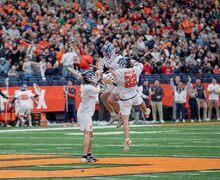Syracuse gets a taste of the wild West at this weekend’s American Finals Rodeo
The air in the Coca-Cola Coliseum isn’t like the air outside. Heavy dust coats your lungs with every breath, and the overpowering stench of manure permeates your skin. The 4,000-seat arena seems permanently enveloped in a thick, toxic haze. Long before the first bronco bucks, the place smells like a rodeo.
The American Professional Rodeo Association held its 26th American Finals Rodeo competition at the New York State Fairgrounds this weekend. And once your senses adapted to the venue’s tear-jerking aroma, the two days of AFR competition made for a fast-paced, death-defying, all-American good time.
The APRA’s top 12 cowboys and cowgirls faced off in eight events, from the cowgirls’ barrel race to the perilous bull rides. The scores for each of three rounds – one on Friday and two on Saturday – were averaged together to determine the winner of the national title and a cash prize.
This is the AFR’s second year in Syracuse. The rodeo moved from Harrisburg, Pa., and has found an increasingly eager audience in Central New York. Parked cars sprawled across the fairgrounds around the coliseum, and some spectators even tailgated in their recreational vehicles.
‘We had more fans here than we did last year,’ said Greg Simas, the rodeo’s announcer. ‘And I think the more times we come here, the word’s going to get out and we’re going to get fans.’
The riders sung the National Anthem and said the Pledge of Allegiance before the event, and squeezed in a ‘cowboy prayer’ between the two salutes to their nation. After the somber, formal opening, they launched the friendly but fierce competition for honor and a paycheck.
Some cowboys say they make a living touring with the rodeo, but most in the business agree that it’s a tough gig.
‘There’s career cowboys, then there’s what we call weekend warriors,’ Simas said. ‘They go to work Monday through Friday and then go rodeo on the weekends. But we had a mix of them all here this weekend. Some make a living out of it, some don’t.’
The season’s top money winner before this weekend’s competition had earned over $10,000 in barrel racing, but most of the participants have pulled in less than $3,000. Many career cowboys have to join multiple tours just to get by.
‘I want to make a career out of it, but it’s kind of tough,’ said Richard Pipech, a bull rider and student at Penn State. ‘I’m 23 years old, they say the better off you are is when you start younger.’
Pipech was named Rookie of the Year when he picked up rodeo three years ago. Most riders don’t make money for their first few years, he said, but his first-year honors helped propel him to profitability.
The eight events – including steer wrestling, bareback riding and calf roping – were punctuated by the antics of the resident rodeo clown, Cowboy Bobby. He entertained the crowd with free T-shirts, roller skating stunts and quick wit.
‘I’ve had the pleasure to work with Bobby,’ Simas said. ‘He’s one of the best not only in the northeast, but in the country.’
Cowboy Bobby was named Motorsports Entertainer of the Year three times for his work on televised monster truck rallies, Simas said.
At the rodeo, though, he deals with real monsters – bulls. Bull riding, the last event on the itinerary and one of the most dangerous competitions in sports, strikes fear in the heart of many cowboys.
‘They call skateboarding an extreme sport,’ Simas told the crowd before the bull rides commenced. ‘This is the original extreme sport.’
The difference is that skateboarders wear more pads. The riders wear protective vests, but only cowboy hats, flannel shirts and denim jeans cover the rest of their bodies.
‘I’ve gotten hurt a number of times,’ said Simas, who rode bulls for eight years before becoming an announcer. ‘It’s not if you get hurt in bull riding. It’s when you get hurt.’
The cowboys try to ride a raging bull for eight seconds, and the APRA brought in its wildest beasts for the finals. None of the cowboys hung on for long enough, and fortunately they all survived without serious injury.
Paramedics were perched on the sidelines in case of disaster, though, and two cowboys were taken to the hospital during the third round. A horse stepped on the chest of the third cowboy in the bareback competition, and another cowboy broke his nose during an unsuccessful ride.
Injury isn’t unusual for these cowboys, and many have been mangled in the past.
‘I’ve had my number of wrecks,’ Simas said. ‘I could sit here and name injuries, but we’d be here all night long.’
‘Concussions,’ said bareback rider Stephan Peloquin. ‘Broken ribs. Fractured my nose, my cheekbone and ear about three weeks ago.’ His face still showed the scars.
Bull riding demands immense physical strength, but the cowboys say it takes more than muscle to last the full eight seconds.
‘It’s more mental than physical,’ Pipech said. ‘If you have in your mind any doubts or anything, that plays a major effect on you.’
Though bull riding is a favorite among the rodeo audience, its danger and demand for discipline are essential in all the rodeo events.
‘I consider rodeo one of the natural sports,’ Simas said. ‘These guys don’t get paid to be here. They have to earn their money, so every event is exciting. If you know how hard it is to do every event in rodeo, then you appreciate every event.’
Published on October 13, 2003 at 12:00 pm





